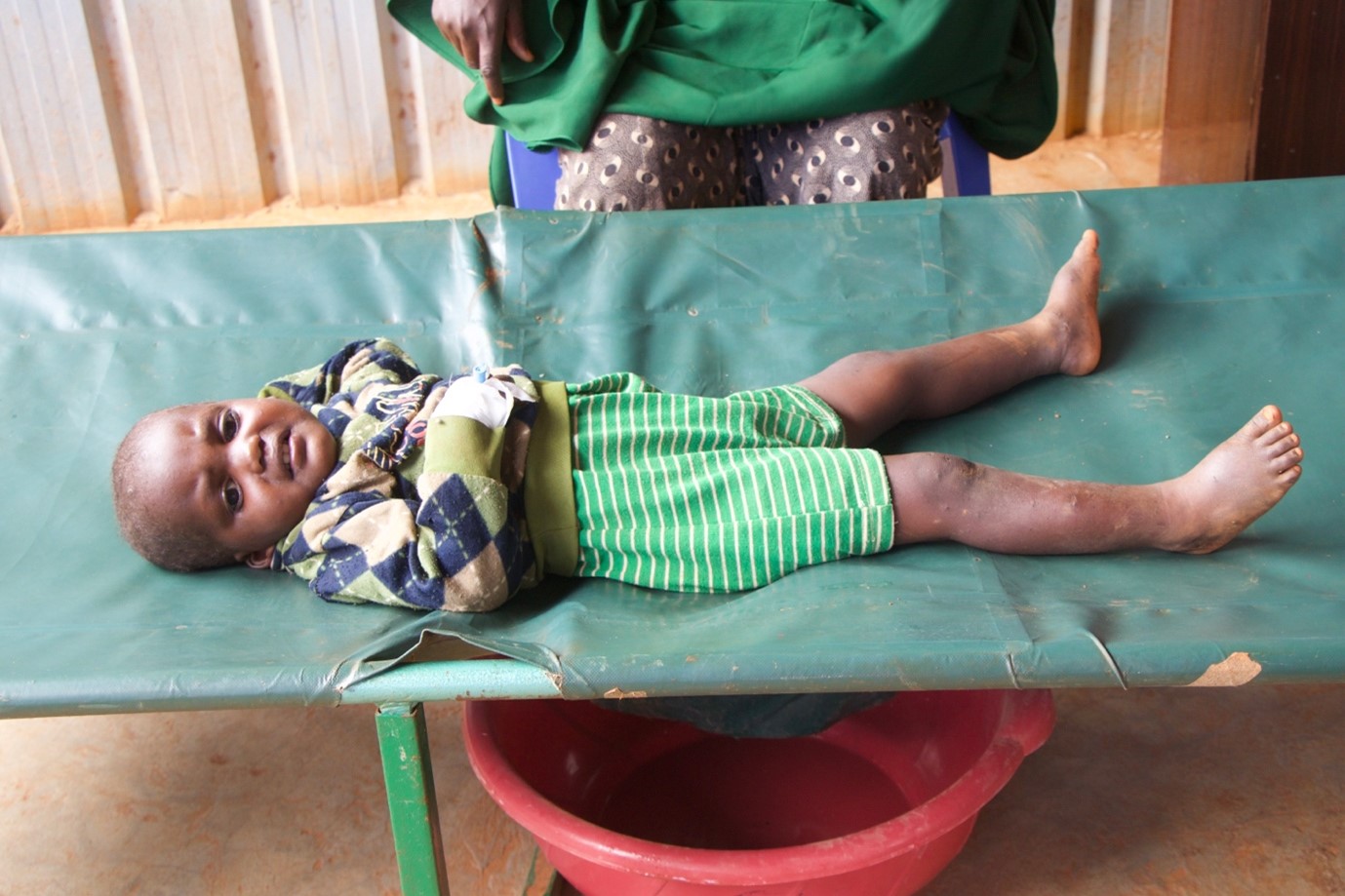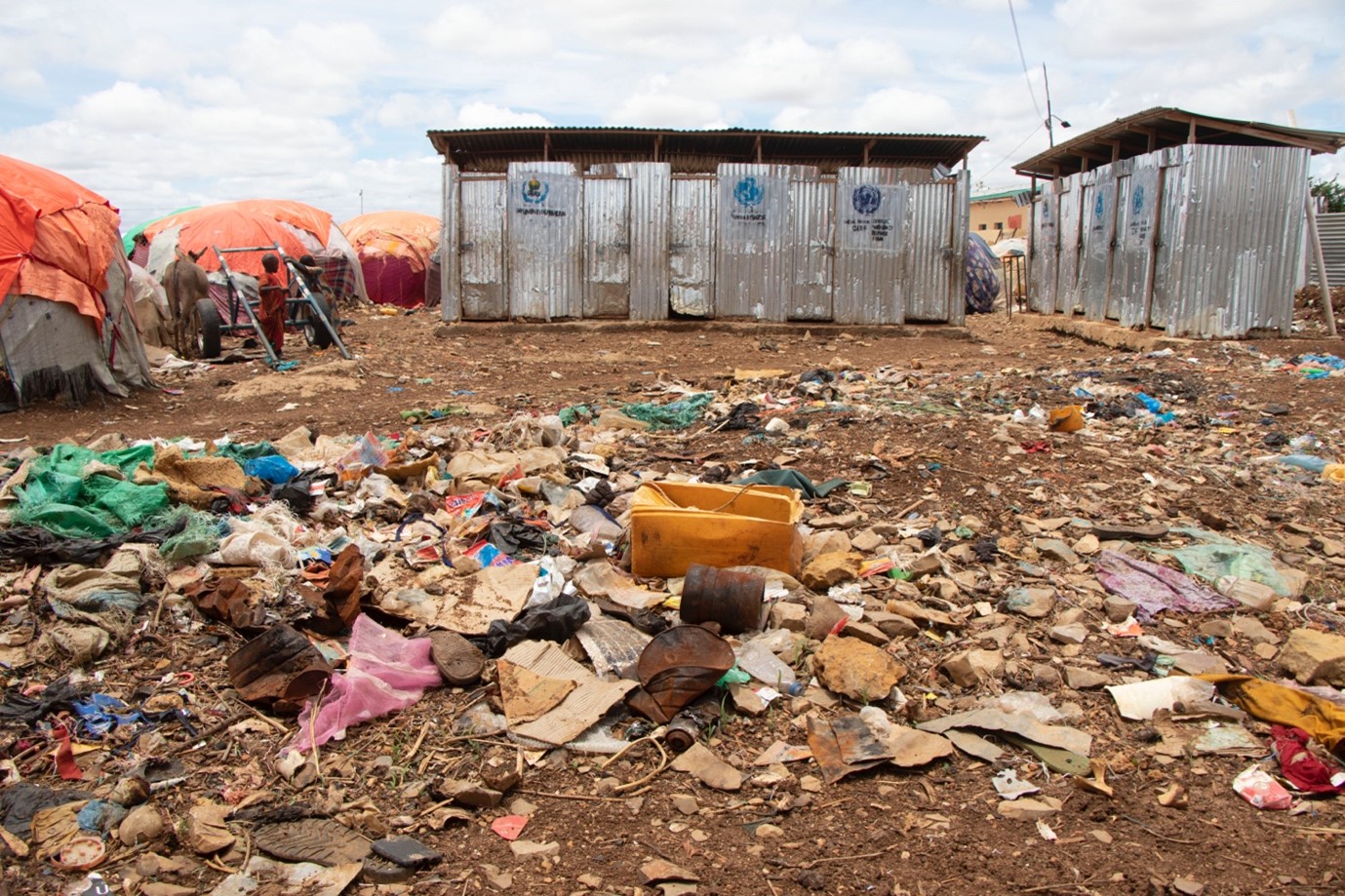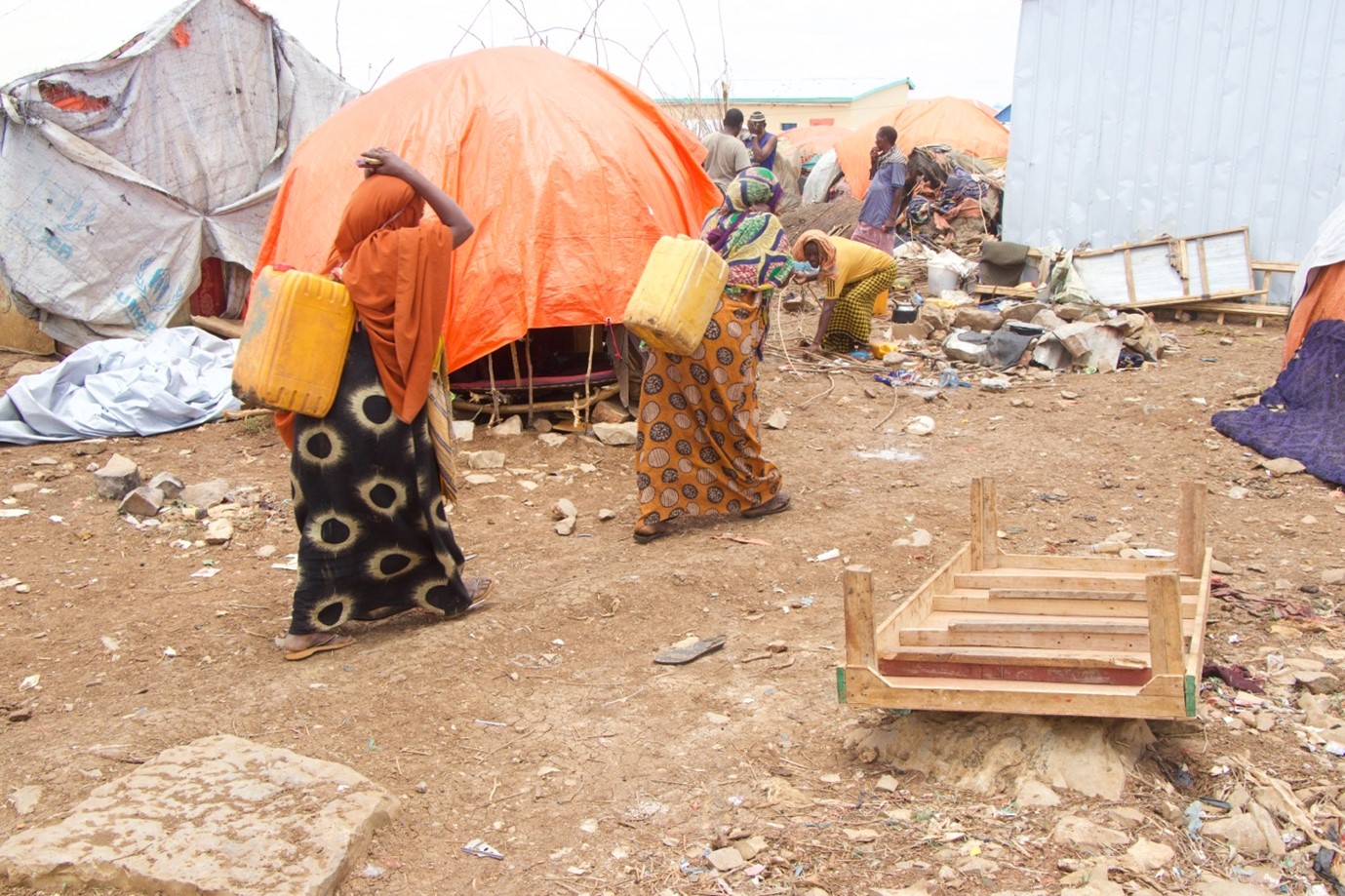Suspected cholera cases surge in Somalia as conflict and a multi-season drought displace more than 1.4 million people, many into camps lacking access to safe water and sanitation
 A 3-year-old Somow lies stretched out on a cholera cot at Bayhow General Hospital in Baidoa, Somalia, 21 March 2023. Credit: WHO/Somalia
A 3-year-old Somow lies stretched out on a cholera cot at Bayhow General Hospital in Baidoa, Somalia, 21 March 2023. Credit: WHO/Somalia
BAIDOA, 17 May 2023 – Stretched out on a cholera cot, 3-year-old Somow defaecates directly into a bucket through a hole in a thin mattress. Since drinking contaminated water, he has been wracked by vomiting and violent episodes of watery diarrhoea.
“He fell ill earlier, and then it came back, that’s when I decided to seek treatment,” his mother, Nuney Ibrahim Yusuf explains, brushing flies from the young boy’s face and legs, at a cholera treatment facility in Baidoa, in southwest Somalia.
Somow is among an increasing number of patients with suspected cholera across Somalia, where forced displacement, poor sanitation and climate shocks are creating the perfect conditions for large-scale outbreaks of the disease.
Nationally, about 8 million people lack access to safe water, sanitation and hygiene services in Somalia, where drought and insecurity displaced 1.4 million people in 2022.
Last year, WHO treated more than 130 000 cases of acute diarrhoeal disease – including 15 600 cases of suspected cholera in cholera treatment centres – the highest number in 5 years, although more cases likely went unreported in this Horn of Africa country owing to underreporting and other weakness in the disease surveillance system.
On his admission to the treatment centre at Bayhow General Hospital in Baidoa, doctors gave Somow oral and intravenous rehydration, and began treatment with antibiotics. He also received zinc supplements, which have been shown to reduce the severity and duration of diarrhoea in children suffering from cholera.
Displaced by insecurity and severe drought, the numbers of internally displaced people trekking to Baidoa reached 660 000 last year, nearly double the number in 2018. Most live in unsanitary conditions in dozens of informal settlements of fragile shelters built of sticks and covered with plastic and rags that ring the city.
“The latrines we have are full, there is nowhere to wash, and we have new people arriving,” says Abdulkadir Abdinur Adan, a community leader at the city’s Raama Cadey settlement, which is home to more than 1800 people. “Children have diarrhoea and there could be a cholera outbreak at any time. It is a great concern,” he adds.
 Shuttered latrines at Raama Cadey camp for internally displaced people in Baidoa, Somalia, 22 March 2023. Credit: WHO Somalia
Shuttered latrines at Raama Cadey camp for internally displaced people in Baidoa, Somalia, 22 March 2023. Credit: WHO Somalia
Like others across Somalia, the settlement comprises tightly packed, single-room shelters hastily erected on bare earth. It has just 10 latrines, all padlocked shut at the time of one recent visit. Open defecation is common, and many residents collect contaminated water from shallow wells, known as war, or hauled in on donkey carts in barrels.
Epidemiologists say waterborne disease transmission is being further exacerbated by a persistent multiyear drought. They cite a recently published retrospective mortality estimates titled “From insight to action: examining mortality in Somalia” according to which 43 000 excess deaths might have happened in 2022 alone. The drought devasted successive crops, killed off livestock and made residents dependent on dwindling sources of water.
“Boreholes dry up, water sources become more scarce, which means more people are concentrating to drink from a single source. If that source is contaminated, you get an outbreak,” says Joaquin Baruch, a WHO epidemiologist. “Cholera is highly contagious and has the risk of increasing and going through the roof very quickly. It can be very explosive if the suspected cases are not identified and treated early on when transmission is ongoing in a community.”
 Women carry water at Raama Cadey camp for internally displaced people in Baidoa, Somalia, 22 March 2023. Credit: WHO Somalia
Women carry water at Raama Cadey camp for internally displaced people in Baidoa, Somalia, 22 March 2023. Credit: WHO Somalia
Cholera is an endemic disease in Somalia. Uninterrupted transmission is ongoing in certain parts of Somalia since 2017. This situation has exacerbated in recent time owing to severe drought in the country and currently, high-levels of transmission is ongoing in four districts in Somalia. As this year’s wet season gets under way with heavy rains and flashfloods in some areas, WHO is very concerned that cholera cases could rise sharply among the forcibly displaced owing to rapid community spread as cholera organisms thrive and survive in contaminated water.
“Displacement is driving people into camps where access to clean water and sanitation are extremely limited,” warned WHO Representative to Somalia, Dr Mamunur Rahman Malik. “Cholera is present, and there is a serious risk of an explosive outbreak that would prove difficult to contain if early actions and recommended public health measures such as availability of safe drinking water and safe sanitation services, improved hygiene and improved access to treatment are not ensured.”
In a race to prevent it, WHO is working closely with the Ministry of Health and Human Services to ensure that everyone suffering from acute watery diarrhoea has access to early treatment and care. WHO is also working to implement reactive vaccination campiagn using oral cholera vaccine (OCV) in the hotspots In addition, it is improving access to primary health care services and working with its partners such as UNCEF to improve availability of safe water and adequate sanitation for the high-risk populations.
But for many Somalis, displaced from their homes by conflict and drought, the issue remains a lack of access to potable safe water. In Baidoa, clean water is available at a cost of three US cents per litre, a sum out of the reach of most displaced people, like Nuney, who lost her livelihood when drought forced her to abandon her land.
“We don’t have any source of money to buy clean water, so we use the well,” says Nuney, who is concerned for Somow once he is discharged. “I am worried that if he drinks that water, he will fall sick again,” she adds.
On the other side of the cholera treatment ward is Hasale Khalif Jibi, standing vigil beside her 18-month-old son, Abdi Hasanow. The youngster was admitted the previous evening with violent diarrhoea and vomiting after drinking water from a communal well at a displacement camp. He too is on the mend after treatment, although Hasale remains concerned for his chances of staying healthy once discharged. “Nothing has changed,” she says, with resignation. “The water is there, and we will drink it.”
 Hasale Khalif Jibi sits with her 18-month-old son Abdi Hasanow at a cholera treatment centre at Bayhow General Hospital in Baidoa, Somalia, 21 March 2023. Credit: WHO Somalia.
Hasale Khalif Jibi sits with her 18-month-old son Abdi Hasanow at a cholera treatment centre at Bayhow General Hospital in Baidoa, Somalia, 21 March 2023. Credit: WHO Somalia.
For additional information, please contact:
Kyle DeFreitas, External Relations Officer,
Fouzia Bano, Communications Officer,
Related links
Please see the links below for additional information:
Acute watery diarrhoea/cholera situation report, Week 16, 17-23 April 2023
/images/stories/somalia/documents/technical-programme-update-september-december-2022.pdf?ua=1


